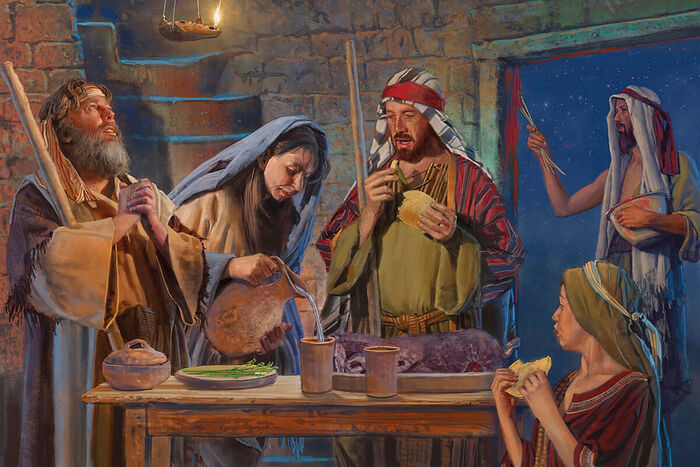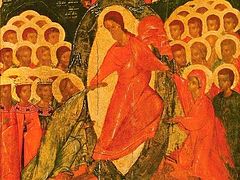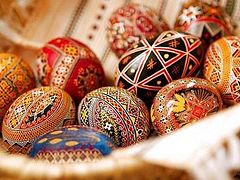The origin of the most important celebration of the New Testament era is the Feast of Christian Easter or Pascha, which Orthodox interpreters recognize to have had a directly related forerunner in the face of another, Old Testament Pascha or as it is known in Jewish “Pesach”.
The Old Testament Pesach is a Feast which was established to commemorate the Exodus—the liberation of the Jewish people from their captivity in Egypt, where they were enslaved, oppressed and had to undertake the most laborious physical work.
The word “Pesach” in Hebrew means “passing by”; hence it’s called “Passover” in English. The seemingly strange meaning of this word starts to make sense when we turn to the book of Exodus (Ex 1–14). The Old Testament prophet and righteous man Moses lived in Egypt for many years until one day he received the command from God to lead his people out of captivity, and so he asked for permission from the Egyptian Pharaoh for such an “exodus” of the Jews. The pharaoh refused to let them go, and so the Lord Himself sent ten “plagues” upon Egypt. The great calamities were meant to make the ruler “see the light” and to force him to let the Jewish people go. The last of the plagues was the destruction of all of the firstborn (eldest sons) of Egypt.
One night an angel passed through Egypt and smote all the firstborn—both man and beast (Ex. 12:12). He only passed over the houses (Ex. 12:27) (hence the concept of “Passover”) on the doors on which the Jewish people, as directed by God, had marked a special sign. The Lord commanded the Jews to choose a one-year-old male lamb for each family, slaughter it, roast it, then eat it with unleavened bread and with bitter herbs, without breaking its bones. They were to anoint with blood of “the lamb” the two side posts and on the upper door post of their houses.
After the death of the firstborn of the Egyptians, the pharaoh was forced to free the Jewish people out of slavery. Although, later on he regretted this decision and began to pursue them. Yet the pharaoh’s army perished in the depths of the Red Sea: The waters of the sea parted and allowed only Moses and his people to pass, then closed again and swallowed up the Egyptians (Ex 14).
For many centuries to come, the Jews commemorated the day called “Passover” as the day of liberation from slavery. Every year on the same day, the 14 Aviv or Nisan, the Jewish families were to prepare a sacrificial lamb in order to eat it with unleavened bread, bitter herbs, sweet fruit salad and wine. That day, psalms and special thanksgiving prayers were to be read and the eldest family member was to tell the younger ones about the exodus of Jews from Egypt. The same tradition was fulfilled by Christ, together with his disciples-apostles; the famous Last Supper was just such an Old Testament Passover meal, but the Savior made it complete by establishing in it the sacrament of the Eucharist.
According to the Jewish tradition, the Passover celebration lasted seven days.
The New Testament interpreters understand the most important features of this Old Testament celebration to be the signs of the future events that were fulfilled by the Incarnation of Christ. This way the Passover lamb, by whose blood the Jewish firstborn were delivered from death, symbolize Christ Himself, the Lamb of God, who takes away the sins of the world. All who believe in Him are similarly delivered from eternal death by the blood of this new Lamb, the Son of God. In the same way, the bones of the Hebrew Passover lamb were not allowed to be broken, in the very same way the legs of the Savior were not broken by the Roman soldiers as He died before they could do it (by breaking the legs of the crucified on the cross it was possible to hasten his death; see Jn 19:31–37).
Lastly, the bread and wine of the Passover symbolize the Eucharistic Bread and Wine. The Jewish Passover itself as a whole became the herald of the New Testament Passover—as the deliverance of the whole world from slavery to sin and death. In the same way as death once passed over the Jewish dwellings in Egypt and the Jews themselves received the long-awaited freedom, so did the Resurrection of Christ (New Testament Passover) free people from slavery to evil, as the eternal death passed us by and was defeated by the Eternal Life—Christ Himself.
Jesus died on the Cross on the very day when the Jews traditionally killed their Passover lamb, and He rose again when the first and the most important day of the Passover celebration had already passed: that is why the Christian Passover, according to the decision of the Church Councils, should not coincide with the Passover day, but is relayed to the first Sunday after the spring’s full moon.




